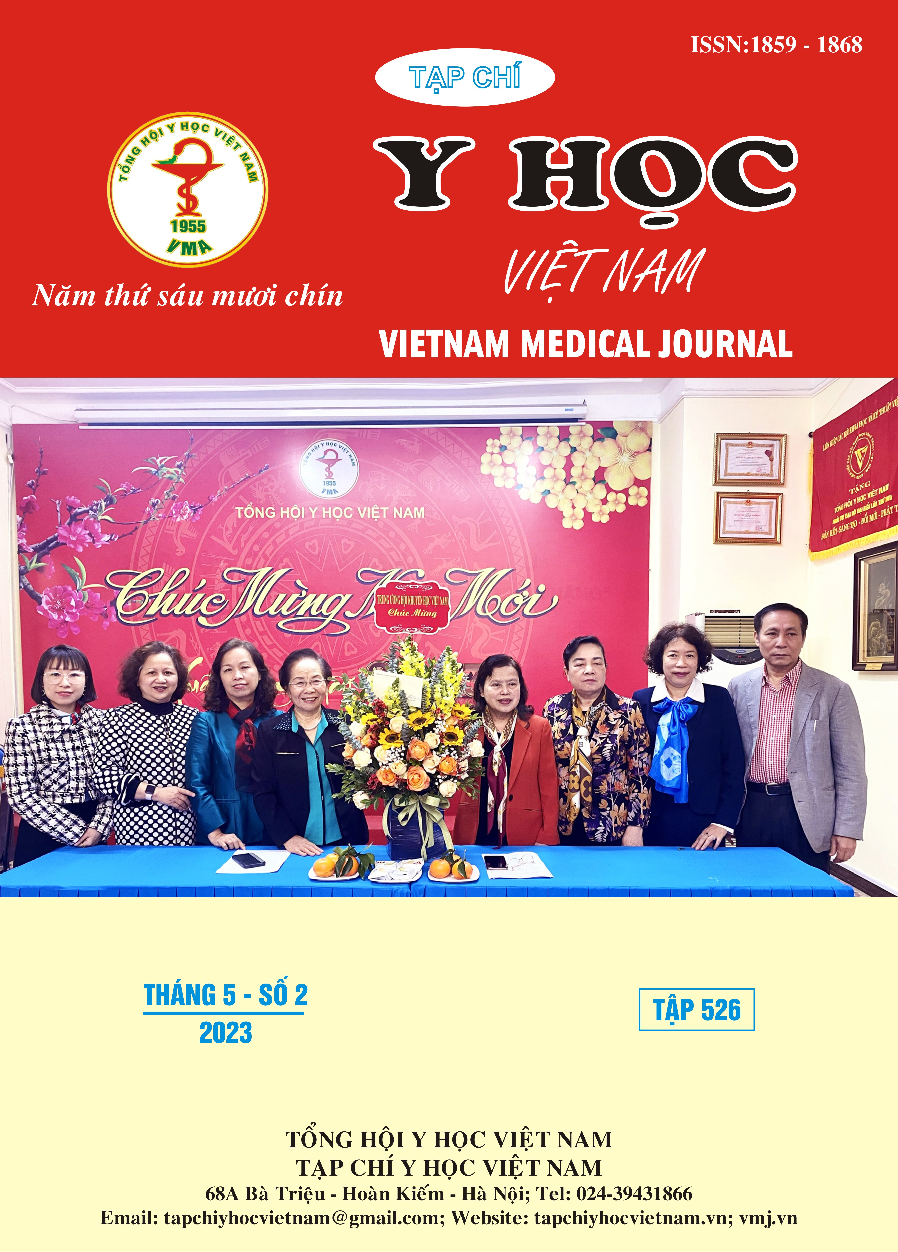IMAGING FEATURES OF ACUTE CEREBRAL INFARCTION DUE TO OCCLUSION OF THE M2 BRANCHES OF THE MIDDLE CEREBRAL ARTERY
Main Article Content
Abstract
Objectives: To describe the image features of acute cerebral infarction due to occlusion of the M2 branches of the middle cerebral artery at Bach Mai Hospital. Subjects and methods: A cross-sectional descriptive study on 38 patients diagnosed with acute ischemic stroke due to occlusion of the M2 branches of the middle cerebral artery at the Radiology Center of Bach Mai Hospital from January 2018 to June 2021. Results: The mean age of the patients was 70.5 years old; the female/male ratio was 1.38, and the mean NIHSS score on admission was 14.26. The mean time from onset to performing computed tomography was 192.74 ± 124.92 minutes. The rate of hyperdense artery sign, loss of the gray-white matter interface, sulcal effacement, and loss of insular ribbon sign was 67.6%, 47.1%, 44.1%, and 26.5%, respectively. The mean time from onset to performing magnetic resonance imaging was 100.75 ± 43.07 minutes. 4/4 of patients increased cerebral parenchymal signal intensity on DWI, but only 1/4 increased signal intensity on FLAIR. The left and right M2 branch occlusion rates were 55% and 45%, respectively. Computed tomography angiography and 3D TOF magnetic resonance angiography had 100% accuracy in diagnosing the location of occlusion when compared to digital subtraction angiography. Conclusions: The imaging features appearing on computed tomography and magnetic resonance imaging were consistent with the patient's time of admission. Computed tomography angiography and 3D TOF magnetic resonance angiography had high values in diagnosing the location of occlusion when compared to digital subtraction angiography.
Article Details
Keywords
computed tomography, magnetic resonance imaging, acute ischemic stroke, middle meningeal artery, Bach Mai hospital
References
2. Park JS, Kwak HS. Manual aspiration thrombectomy using penumbra catheter in patients with acute m2 occlusion: a single-center analysis. J Korean Neurosurg Soc. 2016;59(4):352-356. doi:10.3340/jkns.2016.59.4.352
3. Harsany J, Haring J, Hoferica M, et al. Aspiration thrombectomy as the first-line treatment of M2 occlusions. Interv Neuroradiol. 2020;26(4):383-388. doi:10.1177/1591019920925678
4. Vũ Đăng Lưu, Nguyễn Quang Anh. Kết quả của phương pháp lấy huyết khối bằng dụng cụ cơ học stent Solitaire trong điều trị nhồi máu não tối cấp. Tạp Chí Nghiên Cứu Y Học. 2015;(2):33-40.
5. Bhogal P, Bücke P, Pérez MA, Ganslandt O, Bäzner H, Henkes H. Mechanical Thrombectomy for M2 Occlusions: A Single-Centre Experience. INE. 2017;6(3-4):117-125. doi:10.1159/000458161
6. Menon BK, Hill MD, Davalos A, et al. Efficacy of endovascular thrombectomy in patients with M2 segment middle cerebral artery occlusions: meta-analysis of data from the HERMES Collaboration. Journal of NeuroInterventional Surgery. 2019;11(11):1065-1069. doi:10.1136/neurintsurg-2018-014678
7. van Overbeek EC, Knottnerus ILH, van Oostenbrugge RJ. Disappearing hyperdense middle cerebral artery sign is associated with striatocapsular infarcts on follow-up CT in ischemic stroke patients treated with intravenous thrombolysis. Cerebrovasc Dis. 2010;30(3):285-289. doi:10.1159/000319071
8. Perkins CJ, Kahya E, Roque CT, Roche PE, Newman GC. Fluid-attenuated inversion recovery and diffusion- and perfusion-weighted MRI abnormalities in 117 consecutive patients with stroke symptoms. Stroke. 2001;32(12):2774-2781. doi:10.1161/hs1201.099634
9. Lee KY, Latour LL, Luby M, Hsia AW, Merino JG, Warach S. Distal hyperintense vessels on FLAIR: An MRI marker for collateral circulation in acute stroke? Neurology. 2009;72(13):1134-1139. doi:10.1212/01.wnl.0000345360.80382.69
10. Albers GW, Marks MP, Kemp S, et al. Thrombectomy for Stroke at 6 to 16 Hours with Selection by Perfusion Imaging. N Engl J Med. 2018;378(8):708-718. doi:10.1056/NEJMoa1713973


